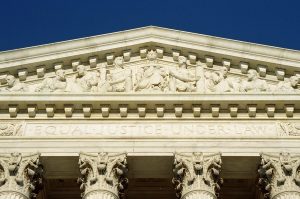On June 2, 2016, the U.S. Court of Appeals for the Fifth Circuit addressed another matter of alleged attorney misconduct in a Deepwater Horizon claims case and the District Court’s authority to impose sanctions for misconduct. This controversy also involves former FBI Director Louis Freeh, who was designated a Special Master by the court when allegations of impropriety surfaced involving Andry Lerner, LLC, a firm that represents claimants in the “Court-Supervised Settlement Program” (CSSP). The Fifth Circuit was asked to review the District Court’s sanction of attorneys after determining that the lawyers violated the Louisiana Rules of Professional Conduct (LRPC).
Articles Posted in Environmental
DC Circuit: NRC Rule Is Not a Licensing Action and Generic EIS Satisfies NEPA
In 2014, the NRC promulgated a “Continued Storage Rule” followed by the Nuclear Regulatory Commission’s (NRC) issuance of a Generic Environmental Impact Statement on Decommissioning of Nuclear Facilities (NUREG-0586) to support the Rule. On June 3, 2016, the U.S. Court of Appeals for the DC Circuit, in State of New York, et al., v. Nuclear Regulatory Commission, et al., rejected the arguments made by “several states, a Native American Community, and numerous environmental organizations” objecting to the Rule and generic EIS concerning the “continued, and possibly indefinite storage” of spent nuclear fuel generated by nuclear power plants operating in the United States.
Vermont’s Generalized Injury Claims from MTBE Contamination Time-Barred
On May 27, 2016, Vermont’s Supreme Court, in State of Vermont v. Atlantic Richfield Company, et al., ruled that the State of Vermont’s “generalized injury” claims “to state waters as a whole due to groundwater contamination from gasoline additives” are not exempted from Vermont’s six-year statute of limitations for civil claims. The Court affirmed the trial courts dismissal of the State’s claims as time-barred, and confirmed that “the trial court properly interpreted [12 Vt. Stat. Ann.] § 462 as limited to claims of adverse possession” and, in addition, recently enacted 10 Vt. Stat. Ann. § 1390 did not “create a new cause of action that was retroactively enforceable, [empowering] the State to apply the statute to injuries discovered more than six years prior to its complaint.”
Congress’ Directive to Service to Reinstate Captive-Bred Exemption Upheld
Since the celebrated Supreme Court decision of Tennessee Valley Authority v. Hill, which for a time sidetracked the  construction of the Tellico Dam, the Endangered Species Act (ESA) has been recognized as a potentially powerful impediment to the construction of many projects. However, as demonstrated by the Congressional response to that case, the Congress can be persuaded to make exceptions from time to time, rare as that may be. The recent Friends of the Animals ruling by the U.S. Court of Appeals for the DC Circuit is also illustrative of this power of the Congress.
construction of the Tellico Dam, the Endangered Species Act (ESA) has been recognized as a potentially powerful impediment to the construction of many projects. However, as demonstrated by the Congressional response to that case, the Congress can be persuaded to make exceptions from time to time, rare as that may be. The recent Friends of the Animals ruling by the U.S. Court of Appeals for the DC Circuit is also illustrative of this power of the Congress.
Colorado Act Provides Immunity for Avalanche-related Injuries
Construing the Colorado Ski Safety Act of 1979, on May 31, the Colorado Supreme Court, in Fleury v. IntraWest Winter Park Operations Corp., held that a fatal avalanche that occurred within the bounds of the Winter Park ski resort was an “inherent danger and risk of skiing” and the Act precludes skiers or their families from bringing claims against the operators for any resulting injuries. The Act is part of Title 33 of the Colorado Revised Code governing Wildlife and Parks and Outdoor Recreation. The Act and the protections provided by it illustrate once more the fact that state legislatures often make public policy decisions like this which balance the importance of a particular industry to a state against the risks that the public will knowingly take in engaging in these activities.
Federal Courts Get a Say in CWA Jurisdictional Determinations by Army Corps of Engineers
Many construction projects are subject to the regulatory requirements of the Clean Water Act (CWA), including the  determination whether an earth-moving operation is covered by a “dredge and fill” permits administered by the U.S. Army Corps of Engineers. If there is a question about the applicability of the CWA to a project, the of Corps of Engineers will determine, on its own initiative or following a request for a determination by the project sponsor, whether or not the project is subject to the CWA. However, the administrative procedures employed by the Corps of Engineers to decide whether the project is covered can often be so costly and time-consuming that the project may be abandoned. Now, in the case of the U.S. Amy Corps of Engineers v. Hawkes Co., Inc., decided May 31, the Supreme Court has acknowledged some of these costs, and the serious legal consequences that attend these proceedings, as it has ruled that in appropriate cases, a controversial jurisdictional determination by Corps officials that a project is covered by the CWA is subject to judicial review by the federal courts.
determination whether an earth-moving operation is covered by a “dredge and fill” permits administered by the U.S. Army Corps of Engineers. If there is a question about the applicability of the CWA to a project, the of Corps of Engineers will determine, on its own initiative or following a request for a determination by the project sponsor, whether or not the project is subject to the CWA. However, the administrative procedures employed by the Corps of Engineers to decide whether the project is covered can often be so costly and time-consuming that the project may be abandoned. Now, in the case of the U.S. Amy Corps of Engineers v. Hawkes Co., Inc., decided May 31, the Supreme Court has acknowledged some of these costs, and the serious legal consequences that attend these proceedings, as it has ruled that in appropriate cases, a controversial jurisdictional determination by Corps officials that a project is covered by the CWA is subject to judicial review by the federal courts.
When Contract is Silent, Accommodation Doctrine Applies to Water Rights Disputes
A case that has been closely followed by oil and gas and other interests which involves groundwater disputes has now been decided by the Texas Supreme Court. In Coyote Lake Ranch, LLC, v. The City of Lubbock, decided on May 27, the Court held that the “accommodation doctrine,” a doctrine developed by the courts to assist in the resolution of disputes between landowners and their oil and gas lessees, can play a significant role in the resolution of disputes between landowners and the owner of an interest in the groundwater beneath the land. The doctrine refers to the rule that “[a]bsent an agreement to the contrary, an oil-and-gas lessee has an implied right to use the land as reasonably necessary to produce and remove the minerals but must exercise that right with due regard for the landowner’s rights. In so ruling, the Court reversed the U.S. Court of Appeals for the Seventh District sitting in Amarillo, Texas.
Commonality and Cohesiveness Lacking for Class Contamination Claims
On May 20, 2016, the U.S. Court of Appeals for the Eighth Circuit, in Ebert, et al., v. General Mills, Inc., reversed the federal district court’s decision to grant class certification in an environmental contamination lawsuit. The district court had found that the requisites of Federal Rule of Civil Procedure 23 had been satisfied with respect to the proposed class of “all persons and non-governmental entities that own residential property within the ‘Class Area.'” The proposed class members were expected to assert five legal claims: (1) violation of the Comprehensive Environmental Response, Compensation, and Liability Act (CERCLA); (2) common law negligence; (3) private nuisance; (4) willful and wanton misconduct; and (5) violation of the Resource Conservation and Recovery Act (RCRA). The Eight Circuit disagreed with the district courts findings, instead concluding that the proposed class lacks the requisite commonality and cohesiveness to satisfy Rule 23.
Things Getting Hot for Massachusetts Department of Environmental Protection
On May 17, 2016, the Supreme Judicial Court of Massachusetts, in Isabel Kain & Others v. Department of Environmental Protection, held that the various existing greenhouse gas rules and initiatives promulgated by the Commonwealth of Massachusetts Department of Environmental Protection (DEP) did not satisfy the strict requirements of the state’s Global Warming Solutions Act. The purpose of the Act “is to attain actual, measurable, and permanent emissions reductions in the Commonwealth.” According to the Court, the unambiguous language of Section 3 (d) of the Act “requires the department to promulgate regulations that establish volumetric limits on multiple greenhouse gas emissions sources, expressed in carbon dioxide equivalents, and that such limits must decline on an annual basis.” DEP’s duty under the law was described by DEP as being mostly aspirational, but the Court held this was insufficient.
104(e) Letter Triggers Duty to Defend
According to the Ninth Circuit Court of Appeals, in Ash Grove Cement Co. v. Liberty Mutual Ins. Co., an unpublished opinion applying Oregon law, an insurer’s duty to defend begins with a “104(e) letter” from the EPA and continues for the duration of the regulatory process. In A “Suit” by Any Other Name: Ninth Circuit Rules CERCLA 104(e) Letter Triggers Duty to Defend, Pillsbury attorney Alex Lathrop discusses the Ash Grove ruling.
 Gravel2Gavel Construction & Real Estate Law Blog
Gravel2Gavel Construction & Real Estate Law Blog


